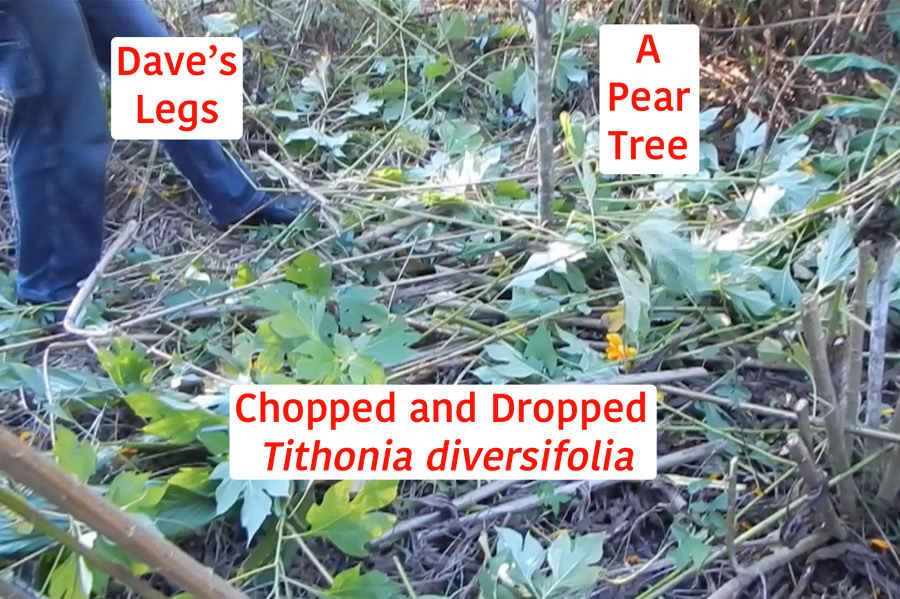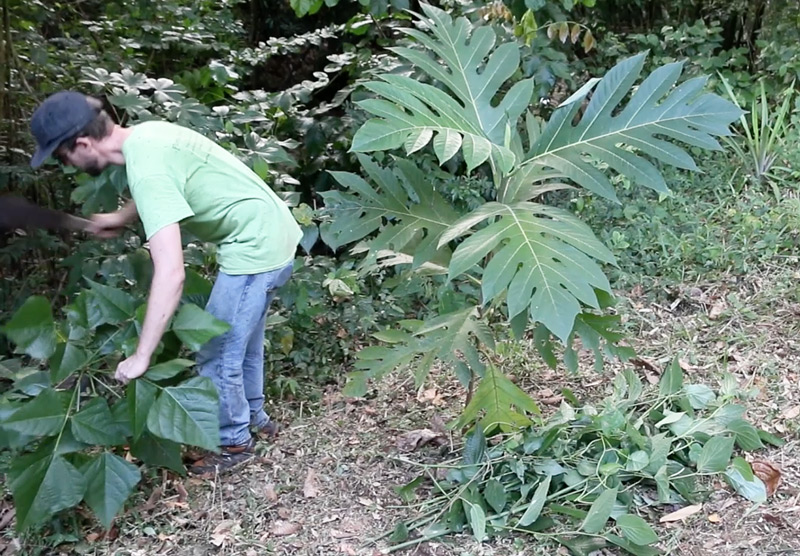I really just can’t get over how great chop and drop is – and I’ve been doing it for years.
In my latest video you can see me use the method to feed and mulch a lovely breadnut a friend gave me when we first moved here.
I got the idea from Geoff Lawton originally and love how easy it is.
Got an invasive tree? Chop and drop it.
Plant fast-growing and nitrogen fixing species, then chop and drop them as mulch around your fruit trees.
There’s a section in my Compost Everything movie where I demonstrate this around a pear tree.

Though I often deliberately plant species to feed my trees, I also use the naturally occurring weeds and grass to build the soil, like this guy:
Weeds are soil bandaids, remember?
We are too quick to knock them down, rake them up and throw them away.
Use them to build soil instead.
One you start thinking about the many trees and weeds you can chop and drop to feed the plants you want to feed, you’ll see all of nature differently.
Chop and drop and build soil in fast forward.


6 comments
Good morning, David. As always I love your videos and helpful information. But I am in need of advice. This past week a friend who runs a tree service dumped a huge pile of chipped oak branches and leaves for me to use. The pile is 20 feet long, 8 feet wide, and 5 feet high at the center peak. I have never had this much volume to deal with at one time. What can I add to the pile to accelerate the decomposition? Is there any worry of combustion from its’ internal cooking? As I removed a large portion of it to be spread around I noticed how hot it was getting after a couple of days. Do I need to separate it into several smaller piles? Thanks.
Congrats on the big pile of good stuff!
I have never heard of tree mulch catching on fire. If you want it to break down faster, add urine, cottonseed meal, blood meal or urea fertilizer.
It’s not necessary, though. I actually like it to break down slower, as Florida has a nasty habit of eating up humus rapidly. Just use it as a thick mulch around trees and perennials. One big pile is fine – I had one like that for a couple of years. When I dug into the middle after a year or so, I found a lot of it was rich, half-broken-down compost with earthworms in it. I used it in my potting soil mixes and it was wonderful.
I didn’t know pumpkins had male and female flowers! I’m half-way through the video and was curious as to why only male flowers were blooming. You and Rachel might be right – fighting with the luffa might have something to do with it.
In a nutshell it looks like ethylene can repress female flower development:
https://www.ncbi.nlm.nih.gov/pubmed/25463265
It may do this by increasing gibberellin clearance/inactivation:
https://www.ncbi.nlm.nih.gov/pubmed/27789625
I love to chop and drop, on a cool afternoon. In winter, I could do it all day – we don’t get bad winters in our parts of Australia. I like to think of it, as what the animals do in the forest. They disturb vegetative matter and disperse it around in various ways too. We’re just more detailed in how we do it.
Lemon grass, pigeon pea and the native wattle trees, are out preferred chop and drop material. I’ve also started experimenting with casurina trees, which has pine-needle like leaves. After chopping, they grow more, smaller branches. But we also have Old Man salt-bush, and wormwood, which are still reliable producers when the rain isn’t about. It will still grow to be chopped. Those in dry climates, need to search for a native plant that still grows on minimal rainfall, to be their chop and drop material. So it’s not just for the tropics and temperate areas. :)
What is the name of the plant behind you in the first picture?
The video thumbnail? Breadnut.
Comments are closed.